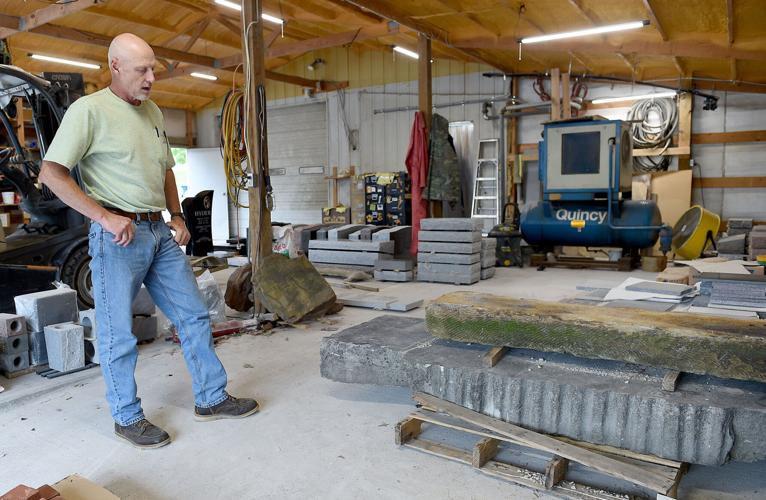A public auction Friday will make it possible to own a piece of locally quarried stone that was once part of the Missouri Capitol.
Carthage limestone cut a century ago and sold by the Carthage Marble Corp. for use on the Capitol is to be auctioned. The stones were replaced during a $50 million renovation that took five years and was finished in 2020.
Much of the local marble used in the construction remains in place. Only a small portion, about 5%, was replaced to repair water damage to the Capitol and its substructure, said Dana Rademan Miller, chief clerk and administrator of the Missouri House of Representatives. She also is a member of the Missouri State Capitol Commission, which oversees the care and maintenance of the building, its artworks and grounds.
Those who directed and worked on the project tried to save as much of the building’s original stone as possible by using Dutchman repairs, which involves grinding off damaged portions and patching the stones using a method that makes the repair less noticeable, Miller said.
“The project was a success in that it sealed the building,” Miller said. “The building had a lot of wind and water damage” that had occurred over the last 100 or so years. She said the fact that most of the stone could be retained is a testament to the strength of the Carthage marble.

The salvaged stone from the Missouri Capitol exterior repair project will be auctioned in lots to the higher bidder Friday. The salvaged Burlington Limestone was mined from the quarries of Carthage. The bulk of the material is large paver stones, along with a variety of architectural cut stones, base stones and capstones, with a few decorative or specialty carved pieces. Courtesy | Missouri Office of Administration
Today’s Capitol is the sixth in the state’s history and the third to be located in Jefferson City, according to state history.
The first Capitol in Jefferson City was built in the period of 1823-1826 and was destroyed by fire in 1837. A second Capitol was completed in 1840 but burned when the dome was struck by lightning in 1911.
Ground was broken May 6, 1913, to build the current Statehouse. The location and a bond issue to finance construction were approved by voters. The building was completed in 1917 and dedicated Oct. 6, 1924.
A state mandate required that only Missouri materials be used in the construction.

Carthage's West Chestnut Monument Co. owner Pat Snyder on Wednesday holds a vintage 1920 photograph of workers inside the Carthage Marble shop.
Globe | Laurie Sisk
Carthage limestone was selected at the time because it is a dense material that could be polished, Miller said. It also is resistant to wear and water, according to information in the National Building Stone Database of the National Parks System. That database also notes that the Carthage stone, with its gray tint, is considered easier on the eye than a solid white type of stone.
Early settlers in the Carthage area began harvesting limestone shortly after the Civil War by carving boulders from outcroppings over hills along the Spring River. It was used to build foundations and chimneys for their cabins and other buildings, according to an undated magazine published by the Carthage Marble Corp. several decades ago.
After fire burned the north side of the Carthage square in 1880, the abundance of lime associated with the limestone formations was used to create mortar and plaster for rebuilding. In 1885, a group of St. Louis businessmen opened a commercial quarry in Carthage and brought in quarrying machinery to produce exterior building stone, according to the booklet.
They shipped the stone to St. Louis to use in building construction, and it became a popular building material, particularly in public and commercial buildings. Some historic homes also used the stone for foundations and pillars and other residential uses.
In this area, the first commercial building to be built with that native stone is the First National Bank of Carthage and later the existing Jasper County Courthouse, according to the company magazine.
Carthage marble was used in a number of historic homes and churches that still stand in the Carthage and Joplin area as well as in the U.S. Capitol, several state capitols, a number of post offices and churches, and other buildings.
The bulk of the items to be sold in Friday’s auction are 2-inch-thick paver stones that range in size from 2-foot to 3-foot squares. There also will be a variety of architectural cut stones, base stones and capstones with a few decorative or specialty carved pieces in the sale.
Pat Snyder, owner of the West Chestnut Monument Co. in Carthage, said that commercial sales of the marble played out around 1970, which resulted in the closing of the Carthage quarry. The quarry is now used to harvest limestone for crushing. and the mined land is now the Carthage Underground operated by the company Americold primarily for food storage warehouse use.
Snyder said he does not know how much the old stone will bring at auction.
“Chances are it might not bring much” for the flat pavers, although the carved pieces are likely to bring higher prices. The main value to Missourians, he said, “is the nostalgia that it used to be on the state Capitol building.”

The salvaged stone from the Missouri Capitol’s exterior repair project will be auctioned in lots to the higher bidder Friday. The salvaged Burlington Limestone was mined from the quarries of Carthage. The bulk of the material is large paver stones, along with a variety of other pieces.
“A lot of people have a misconception about Carthage marble,” Snyder said. “Chances are if you walked on gravel, you’ve walked on Carthage marble because all it is is limestone.”
But when it was cut and sold for architectural uses and monuments, its durability and color was sought after for many government buildings, churches, commercial buildings, houses and cemeteries.
“There’s Carthage marble all over the world,” Snyder said.
And though the crushed rock is widely used, there are still some slabs tucked away in overgrown storage sheds on quarry property that stone masons such as Snyder can access for projects that specifically call for it. But the larger use today is for crushed rock, he said.
The stones to be sold from the Capitol have been assembled on pallets and will be auctioned by the lot to the highest bidder. Photographs of the stones can be viewed online at https://capitol.mo.gov/missouri- state-capitol-commission- presents-historic-capitol- stone-auction or in person before the auction opens at 10 a.m. Friday at 1635 Industrial Drive in Jefferson City.



















Commented
Sorry, there are no recent results for popular commented articles.